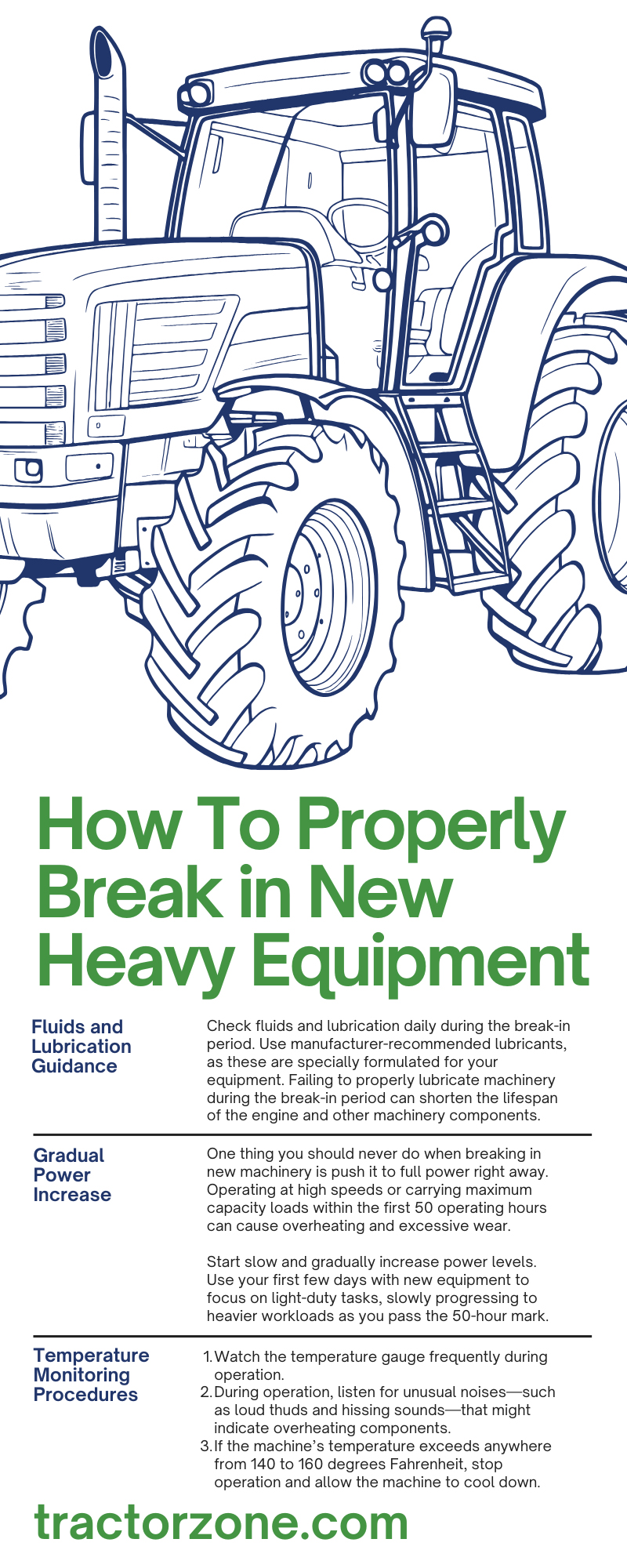How To Properly Break in New Heavy Equipment
Mar 14th 2025
Mar 14th 2025
Starting up new heavy equipment for the first time is an exciting moment for operators and fleet managers. But before you rev up that engine and get to work, there’s a process to follow—breaking in the equipment. Properly breaking in machinery not only ensures its long-term performance but also prevents premature wear and tear that could cost substantial time and money in repairs.
This guide will show you how to properly break in new heavy equipment, from inspection checklists to operating techniques, so you can keep your machinery running smoothly for many years.
Breaking in heavy equipment is not a recommendation; it’s a necessary step in owning machinery. When heavy equipment is brand new, its components need time to acclimate. The process produces ample friction due to surface asperities or microscopic metal grit particles.
During the break-in process, these rough surfaces are gradually worn down. If you don’t follow proper break-in procedures, the surface grit can accelerate wear and lead to premature damage to an excavator or bulldozer.
Due to the increased friction between new parts, brand-new machinery requires more operating power than used equipment. This high-friction environment also generates heat, which further emphasizes the need for care during the initial usage period.
Before you start the engine, every piece of new heavy equipment deserves a thorough inspection. Here’s an initial checklist to ensure everything is in top shape before operating brand-new heavy machinery:
Following an inspection checklist will allow you to identify and address small issues before they cause damage during the break-in process.
One of the most critical steps for breaking in new heavy equipment is applying a lubricant. Lubrication reduces friction between moving parts, polishes contact points, and helps establish a protective coating that minimizes wear over time.
However, new machinery and heavy equipment parts do not come with lubrication. Without it, the metal components are more likely to grind and degrade quickly, leading to mechanical failures and expensive repairs.
Check fluids and lubrication daily during the break-in period. Use manufacturer-recommended lubricants, as these are specially formulated for your equipment. Failing to properly lubricate machinery during the break-in period can shorten the lifespan of the engine and other machinery components.
One thing you should never do when breaking in new machinery is push it to full power right away. Operating at high speeds or carrying maximum capacity loads within the first 50 operating hours can cause overheating and excessive wear.
Start slow and gradually increase power levels. Use your first few days with new equipment to focus on light-duty tasks, slowly progressing to heavier workloads as you pass the 50-hour mark.
Many modern heavy equipment engines come equipped with speed limiter systems to regulate this process automatically. If the machine has this feature, make sure it’s enabled during the break-in phase. It acts as a built-in guardrail against high speeds.
When components are new, they generate a higher level of friction than broken-in parts. The extreme friction generates substantial heat, elevating the temperature of the machine’s engine oil and hydraulic fluids.
That’s why it’s essential to monitor internal temperatures during the break-in period. It prevents the machine from overheating and serious damage.
By keeping an eye on your equipment’s temperature, you can prevent long-term issues before they start.
Running the engine at one speed for extended periods can put unnecessary strain on specific components. Excessive idling causes incomplete combustion and internal damage.
By practicing flexibility during the break-in period, you’ll enable your equipment to adjust to a wide range of operating conditions.
While the break-in period typically ends after the first 50 hours, routine maintenance ensures a smooth transition from new to fully operational equipment.
These regular checkups will reveal how your equipment handles the break-in period. As a result, you can make informed decisions about future maintenance.
The success of the break-in process relies heavily on training and communication among your team. Make sure everyone involved in equipment operation understands how to handle this phase by following these steps:
An informed team is your best defense against improper usage, ensuring your equipment gets the care it needs during these critical early hours.
Knowing how to properly break in new heavy equipment extends its lifespan and maximizes its performance. From initial inspections to gradual power increases, every step you take during the break-in phase is an investment in your equipment’s reliability.
With the right preparation, monitoring, and training, you can keep your fleet in top shape and ready to tackle any project. Explore Tractor Zone’s website for more expert tips and resources on equipment maintenance.
